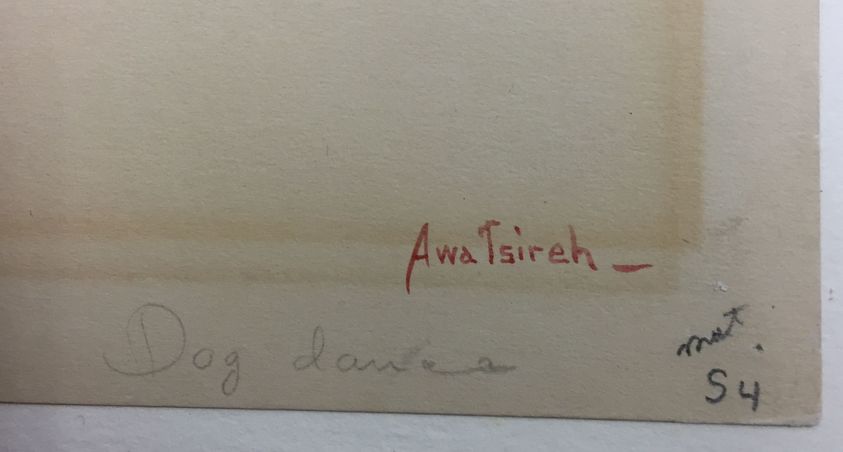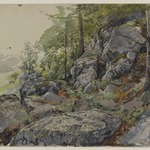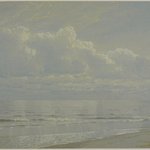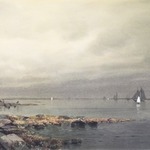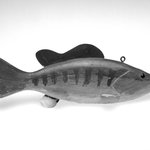
This image is presented as a "thumbnail" because it is protected by copyright. The Brooklyn Museum respects the rights of artists who retain the copyright to their work.

Awa Tsireh (Alfonso Roybal) (Po–who–ge–oweenge (San Ildefonso Pueblo), 1895–1955). Dog Dancer, 1930s. Black ink and watercolor over graphite on wove paper, 11 1/8 x 14 1/8 in. (28.3 x 35.8 cm). Brooklyn Museum, Dick S. Ramsay Fund, 40.89. © artist or artist's estate (Photo: , CUR.40.89.jpg)

Awa Tsireh (Alfonso Roybal) (Po–who–ge–oweenge (San Ildefonso Pueblo), 1895–1955). Dog Dancer, 1930s. Black ink and watercolor over graphite on wove paper, 11 1/8 x 14 1/8 in. (28.3 x 35.8 cm). Brooklyn Museum, Dick S. Ramsay Fund, 40.89. © artist or artist's estate (Photo: Brooklyn Museum, 40.89_bw_SL1.jpg)
Dog Dancer
Arts of the Americas
In the first quarter of the twentieth century, a tradition of watercolor easel painting emerged among Pueblo artists in the Southwest. Awa Tsireh from San Ildefonso Pueblo was known for his stylized and abstracted compositions that depict Pueblo dances. These works appealed to the growing local and international markets, accommodating Anglo patrons’ perception of “authentic” Native art. At the same time, however, artists such as Tsireh created their own cultural representations.
MEDIUM
Black ink and watercolor over graphite on wove paper
DATES
1930s
DIMENSIONS
11 1/8 x 14 1/8 in. (28.3 x 35.8 cm) (show scale)
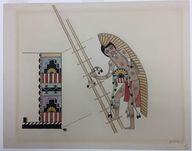


COLLECTIONS
Arts of the Americas
ACCESSION NUMBER
40.89
CREDIT LINE
Dick S. Ramsay Fund
CATALOGUE DESCRIPTION
Watercolor painting of a Pueblo dancer about to climb a ladder leaning against a kiva. Awa Tsireh is also called Alfonso Roybal.
MUSEUM LOCATION
This item is not on view
CAPTION
Awa Tsireh (Alfonso Roybal) (Po–who–ge–oweenge (San Ildefonso Pueblo), 1895–1955). Dog Dancer, 1930s. Black ink and watercolor over graphite on wove paper, 11 1/8 x 14 1/8 in. (28.3 x 35.8 cm). Brooklyn Museum, Dick S. Ramsay Fund, 40.89. © artist or artist's estate (Photo: , CUR.40.89.jpg)
IMAGE
overall, CUR.40.89.jpg., 2019
"CUR" at the beginning of an image file name means that the image was created by a curatorial staff member. These study images may be digital point-and-shoot photographs, when we don\'t yet have high-quality studio photography, or they may be scans of older negatives, slides, or photographic prints, providing historical documentation of the object.
RIGHTS STATEMENT
© artist or artist's estate
Copyright for this work may be controlled by the artist, the artist's estate, or other rights holders. A more detailed analysis of its rights history may, however, place it in the public domain.
The Museum does not warrant that the use of this work will not infringe on the rights of third parties. It is your responsibility to determine and satisfy copyright or other use restrictions before copying, transmitting, or making other use of protected items beyond that allowed by "fair use," as such term is understood under the United States Copyright Act.
For further information about copyright, we recommend resources at the United States Library of Congress, Cornell University, Copyright and Cultural Institutions: Guidelines for U.S. Libraries, Archives, and Museums, and Copyright Watch.
For more information about the Museum's rights project, including how rights types are assigned, please see our blog posts on copyright.
If you have any information regarding this work and rights to it, please contact copyright@brooklynmuseum.org.
RECORD COMPLETENESS
Not every record you will find here is complete. More information is available for some works than for others, and some entries have been updated more recently. Records are frequently reviewed and revised, and we welcome any additional information you might have.
